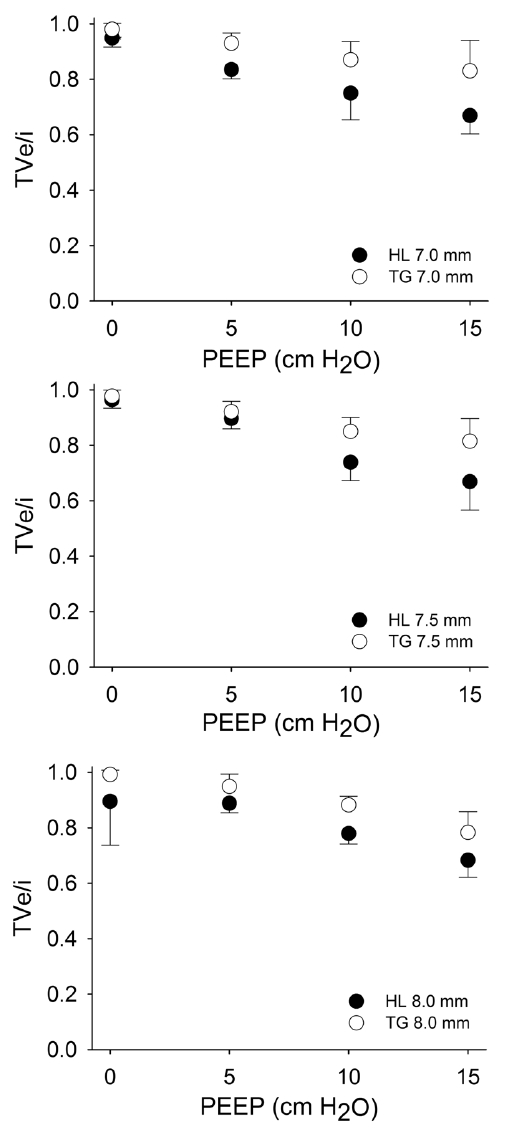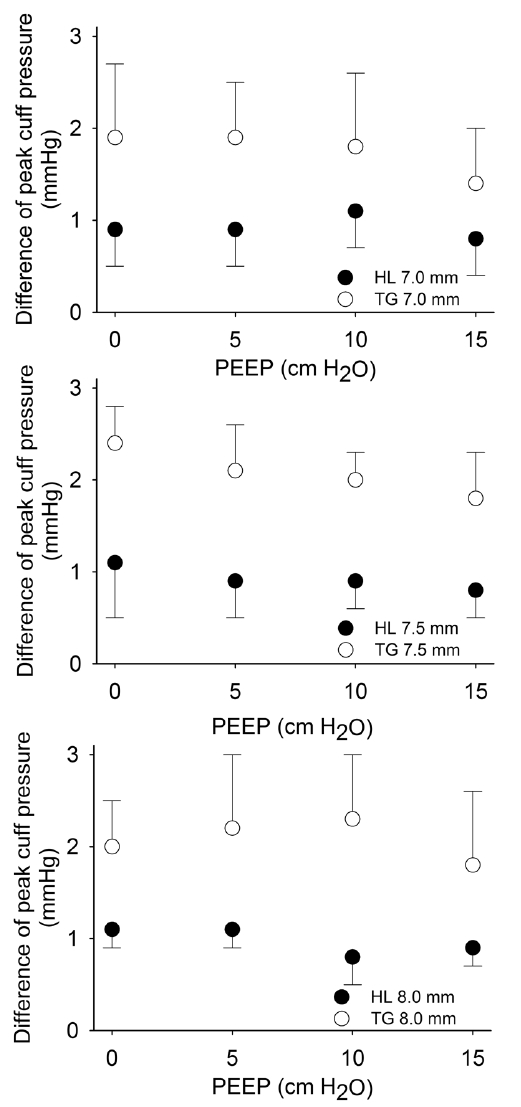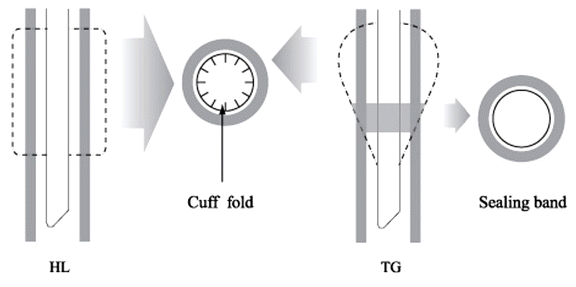Abstract
Background:
Recently developed taper-shaped cuffs (TG cuffs) of endotracheal tubes (ETTs) are known to have a more potent sealing effect than cylindrical high-volume low-pressure cuffs (HL cuffs) of conventional ETTs. The aim of this study was to compare TG cuffs with HL cuffs of ETTs in a bench-top model with regard to air leakage under various positive end-expiratory pressures (PEEP).
Methods:
HL cuffs and TG cuffs made from PVC were included (HL group vs. TG group). A model trachea with an internal diameter (ID) of 22 mm was attached to a test lung. The test lung was ventilated using an anesthesia respirator with volume controlled mode and PEEPs of 0, 5, 10, or 15 cm H2O. Using spirometry, percentages of expired to inspired tidal volumes (TVe/i) were calculated as a measure of air leakage.
Results:
With regard to PEEPs, the HL group showed significantly higher air leakage compared to the TG group (p < 0.0001), and a higher PEEP resulted in greater air leakage (p < 0.0001). Air leakage with higher PEEP was greater in the HL group than in the TG group at ID 7.0 mm and 7.5 mm (p = 0.0467, p = 0.0045)
Advances in the cuff of endotracheal tube (ETT) are mainly about material and shape of the cuff.[1] Recently developed taper-shaped cuff (TG cuff) is known to have more potent sealing effect than conventional cylindrical shaped high-volume low-pressure cuff (HL cuff).[2,3]
Since introduction of TG cuff, bench-top studies about fluid leakage have demonstrated that TG cuff is highly protective against fluid leakage.[3,4] Within the proximal large diameter and the distal small diameter, TG cuff fits into the exact tracheal diameter forming sealing band with minimal folds. And it is presumed that folds formed in the cuff surface are major cause of leakage.[5]
Besides airway protection, ETT also facilitates positive pressure ventilation, particularly when a patient requires high airway pressure. There are high airway pressure cases like decreased lung compliance from pathologic conditions, intervention such as positive end expiratory pressure (PEEP), or both. In these circumstances, an incompetent ETT cuff could compromise ventilation.
To our knowledge, no study has been conducted to address air leakage of ETT according to cuff shape with PEEP applied. We tried to answer whether there is difference of air leakage between TG cuff and HL cuff ETT at variable PEEPs.
HL cuff made from PVC ETT (Hi-LoTM, Covidien, Athlone, Ireland) and TG cuff made from PVC ETT (TaperGuardTM, Covidien, Athlone, Ireland) were included (HL group vs. TG group). Table 1 lists product specifications. The pilot balloon of the ETT was connected to a manometer (VBM Medizintechnik GmbH, Sulz, Germany) with a 10 ml syringe and a three-way stopcock using an extension tube. A model trachea (Smooth-BorTM style 303, Smooth-Bor Plastics, Laguna Hills, CA, USA) with internal diameter (ID) of 22 mm was attached to a test lung (Test Lung 190TM, Maquet Holding GmbH & Co. KG, Rastatt, Germany) (Fig. 1). After the ETT cuff was completely deflated, the model trachea was intubated. The cuff was slowly inflated by the 10 ml syringe until a cuff pressure reached 30 cm H2O, and was controlled to maintain the end-tidal cuff pressure of 30 cm H2O during ventilation.
We set the ventilator on the following: fresh gas flow of 3 L/min, 50% of oxygen with medical air, tidal volume of 300 ml, respiratory rate of 10/min, inspiratory: expiratory time ratio = 1 : 2, and PEEP of 0, 5, 10, or 15 cm H2O. The test lung was ventilated using an anaesthesia respirator (S/5 Avance, Datex-Ohmeda, Helsinki, Finland) for 10 min to ensure a steady state before readings for spirometry (Patient SpirometryTM, Datex-Ohmeda, Helsinki, Finland) were taken. The ventilator switched over to standby mode and then restarted every test. Variables recorded were inspired tidal volume (TVi), expired tidal volume (TVe), peak inspiratory pressure (PIP), and peak cuff pressure (Pcuff). Percentages of expired to inspired tidal volumes (TVe/i) were calculated as a measure for air leakage.
ETTs with PEEPs of 0, 5, 10, and 15 cm H2O were tested, using 8 new Hi-LoTM tubes and 8 new TaperGuardTM tubes for each PEEP. Total 64 tubes were tested once in random order. This brought total 64 data. ETTs with IDs of 7.0, 7.5, and 8.0 mm were investigated by the experimental conditions mentioned above, using 192 new ETTs for this study (192 data were obtained). During experiments, the room temperature was at 20–22°C.
Data are presented as mean (standard deviation). Two-way analysis of variance was used to compare the air leakage between the HL group and TG group of the same ETT ID. Data were analyzed using SAS version 9.3 (SAS Institute Inc., Cary, NC, USA). A p value of < 0.05 was considered significant.
There are the differences in air leakage during ventilation with various PEEPs in Fig. 2. For each size of tube, the HL group show significantly higher air leakage compared with the TG group (p < 0.0001) and higher PEEP triggered greater air leakages (p < 0.0001). There are also some significant differences between the groups regarding interaction of cuff type and PEEP, which means that the air leakages with higher PEEP were greater in HL tubes than in TG tubes (p = 0.0467 for IDs 7.0 mm, p = 0.0045 for IDs 7.5 mm, but p = 0.8261 for IDs 8.0 mm).
The differences in air leakage are presented in Table 2, Fig. 3 demonstrates the change in Pcuff during ventilation with PEEPs. The changes of Pcuff in the TG group show significantly higher than those in the HL group (p < 0.0001), but the level of PEEP does not have any significant effects on the change of Pcuff.
Primary function of ETT cuff is to seal the trachea so that efficient ventilation is possible without aspiration. An incompetent ETT cuff in the face of poor lung compliance or in the cases of high airway pressure could not only compromise ventilation but also make ventilatory management difficult by inaccurate measurement of respiratory variables such as respiratory resistance and compliance.[6]
This in vitro experiment demonstrated that a TG cuff of ETT has a better sealing of air leakage during positive pressure ventilation with PEEP.
We consider several factors to be related to enhanced air sealing in TG.
First, sealing band of TG cuff seems to provide superior sealing effect (Fig. 4). Unlike HL cuff, TG cuff has the proximal large diameter and the distal small diameter. Therefore, TG cuff forms the sealing band, of which diameter is the same as that of trachea and folds are minimized. In the many studies about aspiration demonstrated that longitudinal folds is the main factor of fluid leakage.[1,3,4,7–10] By analogy, the sealing band of TG cuff can reduce air leakage.[11]
Second, peak intra-cuff pressure of TG cuff was higher than HL cuff in our results. Regardless of cuff design, increasing airway pressure is transmitted to the cuff, and then the intra-cuff pressure rises and the cuff presses itself outward into the tracheal mucosa. By this self-sealing action, the cuff can compensate for the increases in airway pressure without additional inflation and can prevent air leakage effectively.[12] Therefore, higher increase in intra-cuff pressure is more effective in preventing air leakage during positive pressure ventilation.
While PEEP is known to prevent fluid leakage across ETT cuff[7] and furthermore decrease ventilator-associated pneumonia,[13] this study showed that air leakage increased with PEEP. This seems to result from the opposite direction of air leakage to fluid leakage. It is thought that the pressure gradient across the cuff, generated by PEEP, inhibits downward movement of fluid to the lung and promotes air leakage from the lung.
This study has some limitations. We used bench top model. The human trachea can expand at the higher airway pressure,[14] affecting on ETT cuff sealing. In addition normal tracheal secretions may also influence ETT cuff sealing. Lastly, the ETT cuff sealing is affected by warmth and humidity in the human trachea.
In conclusion, despite the above limitations this study supports tapered-shaped cuff in its better sealing ability during ventilation with various PEEPs. And higher PEEP triggered more air leakage.
Further studies about air leakage of various ETT type in relation to effect of PEEP are needed.
REFERENCES
1). Dullenkopf A, Gerber A, Weiss M. Fluid leakage past tracheal tube cuffs: evaluation of the new Microcuff endotracheal tube. Intensive Care Med. 2003; 29:1849–53.

2). Madjdpour C, Mauch J, Dave MH, Spielmann N, Weiss M. Comparison of air-sealing characteristics of tapered- vs. cylindrical-shaped high-volume, low-pressure tube cuffs. Acta Anaesthesiol Scand. 2012; 56:230–5.

3). Zanella A, Scaravilli V, Isgrò S, Milan M, Cressoni M, Patroniti N, et al. Fluid leakage across tracheal tube cuff, effect of different cuff material, shape, and positive expiratory pressure: a bench-top study. Intensive Care Med. 2011; 37:343–7.

4). Dave MH, Frotzler A, Spielmann N, Madjdpour C, Weiss M. Effect of tracheal tube cuff shape on fluid leakage across the cuff: an in vitro study. Br J Anaesth. 2010; 105:538–43.

5). Dullenkopf A, Schmitz A, Frei M, Gerber AC, Weiss M. Air leakage around endotracheal tube cuffs. Eur J Anaesthesiol. 2004; 21:448–53.

6). Main E, Castle R, Stocks J, James I, Hatch D. The influence of endotracheal tube leak on the assessment of respiratory function in ventilated children. Intensive Care Med. 2001; 27:1788–97.

7). Pitts R, Fisher D, Sulemanji D, Kratohvil J, Jiang Y, Kacmarek R. Variables affecting leakage past endotracheal tube cuffs: a bench study. Intensive Care Med. 2010; 36:2066–73.

8). Ouanes I, Lyazidi A, Danin PE, Rana N, Di Bari A, Abroug F, et al. Mechanical influences on fluid leakage past the tracheal tube cuff in a benchtop model. Intensive Care Med. 2011; 37:695–700.

9). Young PJ, Blunt MC. Improving the shape and compliance characteristics of a high-volume, low-pressure cuff improves tracheal seal. Br J Anaesth. 1999; 83:887–9.

10). Young PJ, Pakeerathan S, Blunt MC, Subramanya S. A low-volume, low-pressure tracheal tube cuff reduces pulmonary aspiration. Crit Care Med. 2006; 34:632–9.

11). Hwang JY, Park SH, Han SH, Park SJ, Park SK, Kim JH. The effect of tracheal tube size on air leak around the cuffs. Korean J Anesthesiol. 2011; 61:24–9.

12). Guyton D, Banner MJ, Kirby RR. High-volume, low-pressure cuffs. Are they always low pressure? Chest. 1991; 100:1076–81.
Fig. 1.
The benchtop model. The model trachea was connected to a test lung. Anaesthesia respirator was connected to the proximal end of endotracheal tube (ETT), allowing for ventilation with recording of spirometry. In order to measure the cuff pressure manometer was attached to the pilot balloon of ETT.

Fig. 2.
The air leakage under various positive end-expiratory pressures (PEEPs). There are the differences in TVe/i (percentages of expired to inspired tidal volumes as a measure for air leakage) during ventilation with various PEEPs. For each size of tube, the Mallinckrodt Hi-LoTM tube (HL) group shows significantly higher air leakage compared with the Mallinckrodt TaperGuardTM (TG) group (p < 0.0001) and higher positive end-expiratory pressure (PEEP) triggered greater Tve/i (p < 0.0001). There are also some significant differences between the groups regarding interaction of cuff type and PEEP (two-way analysis of variance), which means that the TVe/i with higher PEEP are greater in TG tubes than in HL tubes (p = 0.0467 for IDs 7.0 mm and p = 0.0045 for IDs 7.5 mm).

Fig. 3.
The change in peak cuff pressures (Pcuff) during ventilation with positive end-expiratory pressures (PEEPs). The change of Pcuff in the TG group showed significantly higher than those in the HL group (p < 0.0001, respectively), but the level of PEEP does not have any significant effects on the change of Pcuff (p = 0.2552, 0.0573, and 0.3955, respectively). Two-way analysis of variance was applied with Pcuff and PEEP.

Fig. 4.
Hi-LoTM tube (HL), TaperGuardTM tube (TG), and transaxial views. The diameter of HL cuff is larger than the tracheal diameter in the whole length of the cuff. Therefore longitudinal folds develop and act as a channel. But the tapering diameter of TG cuff fits into the exact tracheal diameter somewhere in the length, forming sealing band with minimal folds.

Table 1.
Tested endotracheal tubes with cylindrical-shaped cuffs (Mallinckrodt Hi-LoTM) and tapered-shaped cuffs (Mallinckrodt TaperGuardTM)
Table 2.
Differences in mean ratio of air leakages between the Hi-LoTM tube group with cylindrical-shaped cuff and the TaperGuardTM tube group with tapered-shaped cuff at 10 cmH2O of positive end-expiratory pressure
| Tube size ID (mm) | Difference | 95% CI | p value | |
|---|---|---|---|---|
| 7.0 | −0.120 | −0.210 | −0.031 | 0.0111 |
| 7.5 | −0.111 | −0.174 | −0.047 | 0.0021 |
| 8.0 | −0.103 | −0.140 | −0.066 | < 0.0001 |




 PDF
PDF Citation
Citation Print
Print


 XML Download
XML Download